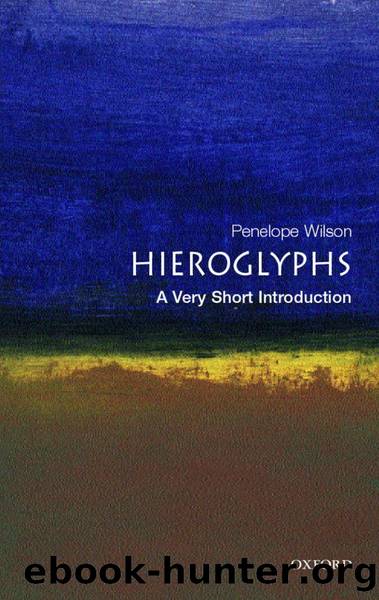Hieroglyphs by Wilson Penelope;

Author:Wilson, Penelope;
Language: eng
Format: epub
Publisher: Oxford University Press, UK
Published: 2004-12-15T00:00:00+00:00
13. Crocodile hymn to Sobek, written in crocodile signs, Temple of Esna.
Perhaps the most extreme examples of cryptography are two texts in the temple of Esna. They are hymns to the crocodile god, Sobek-Re, and the ram god, Khnum, and they can be seen in the Roman pronaos (the front part of the temple), on the inside of a doorway. When the light hits them, the texts are revealed in all their mischievous glory, for the Sobek hymn is written almost entirely in crocodiles and the Khnum hymn in ram hieroglyphs.
Luckily, the Sobek hymn begins with the words âPraise to Sobekâ and then continues in crocodiles. It is clearly a hymn of praise and seems to consist of epithets of the god, extolling his various qualities and attributes, even his crocodileness. From other texts, the crocodile sign has a wide range of possible uses and readings, such as âlordâ, âpower of attackâ, âdivineâ, âSobekâ, âappearing in gloryâ, âtimeâ, âone who seizesâ, and so on.6 The clever thing about the hymns is that the priests who wrote them used the whole hymn as a symbolic message, for both gods are recognized as creator gods, who created everything themselves and are immanent in everything. Therefore, the hymns express the idea that divinity exists in everything through the medium of meaning, sound value, writing, and representation. If one text were needed to express the real triumph of hieroglyphs it would be one of these two.
If such texts hint at the same kind of fun as that to be had in compiling a crossword, there are genuine âacrosticâ texts which can be read in at least two directions. A stela in the tomb of Nebwenenef, from the beginning of the reign of Ramesses II, bears a standard hymn to Osiris and Re written in horizontal lines. Halfway along a pair of vertical lines are drawn down the stela, enclosing one group of hieroglyphs from each line between them. This constitutes a short vertical text. A hymn to Mut on the stela of Paser from the reign of Ramesses VI has taken the process further by writing out every word of a hymn in a squared grid. Two hymns can be read horizontally and vertically. The text actually refers to a third reading which may have been around the outside, though this part of the stela is now lost and so cannot be read.7
There are texts which appear to be written in sportive hieroglyphs but may not be. A stela now in the Louvre (Stela C12) contains a usual funerary inscription for the first few lines of the text and then there is an extraordinary row of figures, carved at about double the height of the usual lines of text. These figures seem to be grouped in a small tableau but they are doing or carrying bizarre things. One man carries a human head on a tray, another wears a mask, and a group of headless beings run along together. This is not usual behaviour for images on such stela or for texts.
Download
This site does not store any files on its server. We only index and link to content provided by other sites. Please contact the content providers to delete copyright contents if any and email us, we'll remove relevant links or contents immediately.
Kathy Andrews Collection by Kathy Andrews(11730)
The remains of the day by Kazuo Ishiguro(8823)
Paper Towns by Green John(5091)
Spare by Prince Harry The Duke of Sussex(5072)
Industrial Automation from Scratch: A hands-on guide to using sensors, actuators, PLCs, HMIs, and SCADA to automate industrial processes by Olushola Akande(4982)
The Body: A Guide for Occupants by Bill Bryson(4974)
Machine Learning at Scale with H2O by Gregory Keys | David Whiting(4183)
Be in a Treehouse by Pete Nelson(3948)
Never by Ken Follett(3791)
Harry Potter and the Goblet Of Fire by J.K. Rowling(3775)
Goodbye Paradise(3728)
Into Thin Air by Jon Krakauer(3313)
The Remains of the Day by Kazuo Ishiguro(3293)
The Cellar by Natasha Preston(3262)
The Genius of Japanese Carpentry by Azby Brown(3224)
Fairy Tale by Stephen King(3220)
120 Days of Sodom by Marquis de Sade(3182)
The Man Who Died Twice by Richard Osman(2997)
Drawing Shortcuts: Developing Quick Drawing Skills Using Today's Technology by Leggitt Jim(2996)
